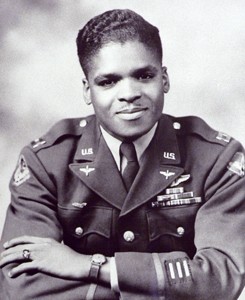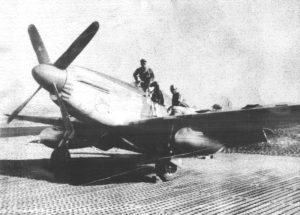
Luther H. Smith was born in Des Moines, September 27, 1920, and grew up in a loving family with eight siblings. He knew he loved flying from a very young age. When he was 11 years old, he and his brother found $5 in a field. He convinced his brother to use their newfound fortune to pay a pilot to take them on a flight. After this, he would walk 5 miles to and from the airport where he would do odd jobs for anyone who needed it, and hope that they would take him on a flight in appreciation.
In 1938, Smith enrolled at the University of Iowa, where he studied mechanical engineering. The United States had not yet joined World War II, but at that point it was clear that a large number of pilots would be needed in the near future. As a result, Civilian Pilot Training Programs were established on campuses across the country in 1939. Smith knew that at that point, the U.S. military did not allow African Americans to serve as pilots, but he was determined to be prepared. He joined the Civilian Pilot Training Program and earned his pilot’s license in 1940. He was on of the first Black Americans do to so.
After joining WWII, the military changed their tune, and allowed Black men to serve as pilots, and in 1942, Smith would enlist in the Army Air Corps in September 1942 and become one of the original Tuskegee Airmen. He served in the 332nd Fighter Group of the 302nd Fighter Squadron. Smith joined the war effort in Europe in January of 1944, based out of Italy. By October of that year, he had flown 133 missions.

On October 13, 1944, Smith’s plane, a P-47 Mustang, was hit during an escort mission over Yugoslavia. He would later say of that day “I flew 133 missions. On the last one, I didn’t make it back. It was Friday the 13th. It was my lucky day – I’m still alive.” He was able to bail out of the plane, but fell through trees, and landed on a branch, fracturing his hip. he was captured as a Prisoner of War and taken to a military hospital. Soon after, he was moved to Stalag XVIII-A, a prisoner of war camp in southern Austria. He would remain a POW for seven months, and was liberated in early May of 1945. At the time of his rescue, he weight only 70 pounds. He returned to the States, where his recovery and rehabilitation would take an additional 2 years and require 18 surgeries. He would be left with lifelong health issues. In 1947, Smith retired from the U.S. Air Force with the rank of Captain. He was the recipient of many medals, including the Distinguished Flying Cross, the Air Medal with six Oak Leaf Clusters, the Prisoner of War Medal, the American Campaign Medal, the Distinguished Flying Cross, the European-African-Middle Eastern Campaign Medal, the Purple Heart, and the WWII Victory Medal.
Smith returned to Iowa City and completed his Bachelors in Mechanical Engineering in 1950. He moved to Schenectady, NY to take a job with General Electric, where he would also be active in the local chapter of the NAACP. He later accepted a position with the company that moved him and his wife to Philadelphia, PA where he earned a Masters degree in Metallurgical Engineering from Penn State. Smith would work for GE for 37 years. He held two U.S. Patents on dynamic sealing devices in aircraft, regularly published technical papers, and worked on projects with the U.S. Air Force, NASA, and U.S. Navy Submarine Command.
In 2000, he began speaking publicly about his time in the war, including about the impact of racial inequality in the military. He accompanied president Bill Clinton on a trip to Europe to commemorate the 50th anniversary of the end of the war. In 2006, Tuskegee University awarded him with an honorary doctorate. He was part of the Architect-Engineer Evaluation Jury for the National World War II Memorial in Washington. In 2007 he was awarded the Congressional Gold Medal for his service as part of the Tuskegee Airmen. Captain Smith passed away in 2009 at the age of 89 and is buried at Arlington National Cemetery.
Works Cited:
American Air Museum in Britain. (n.d.). Luther H Smith | American Air Museum in Britain. https://www.americanairmuseum.com/person/241764
CAF Rise Above. (2018, October 17). Luther H. Smith. https://cafriseabove.org/luther-h-smith/
Iowa Aviation Museum. (n.d.). Luther H. Smith – Iowa Aviation Museum. http://flyingmuseum.com/hall-of-fame/1994-luther-smith/
Saylor, T. (2005, February 18). Oral History Project World War II Years, 1941–1946 – Luther Smith, Jr. DigitalCommons@CSP. https://digitalcommons.csp.edu/oral-history_ww2/75/
University of Iowa College of Engineering. (n.d.). Luther H. Smith. College of Engineering – The University of Iowa. https://engineering.uiowa.edu/alumni-and-friends/awards-alumni-and-friends/honor-wall/distinguished-engineering-alumni-academy-9
University of Iowa Libraries. (n.d.). UI Collection Guides -Civilian Pilot Training Program Records, 1942–1944. http://collguides.lib.uiowa.edu/?RG10.0003.002